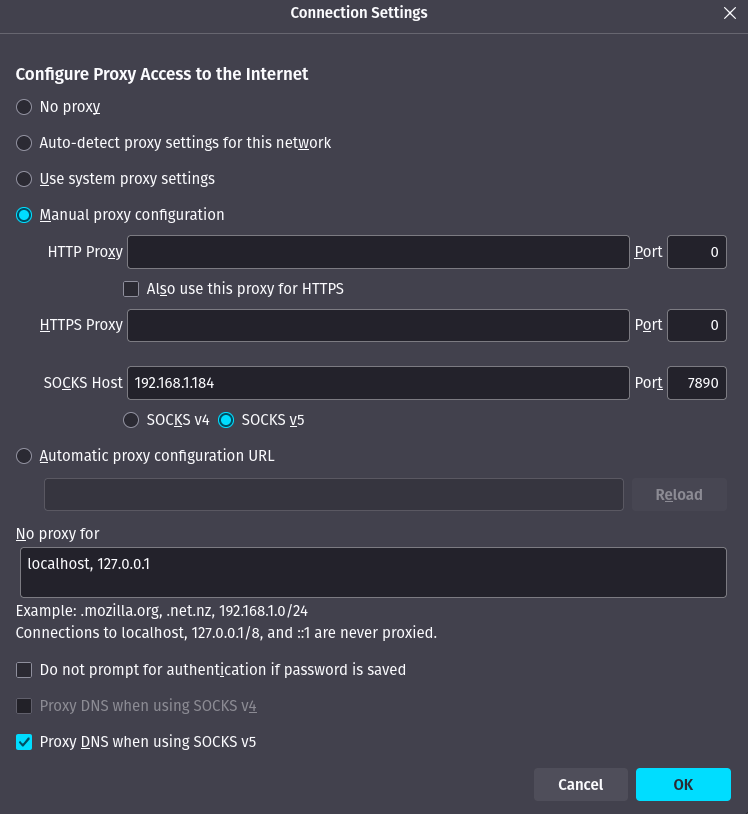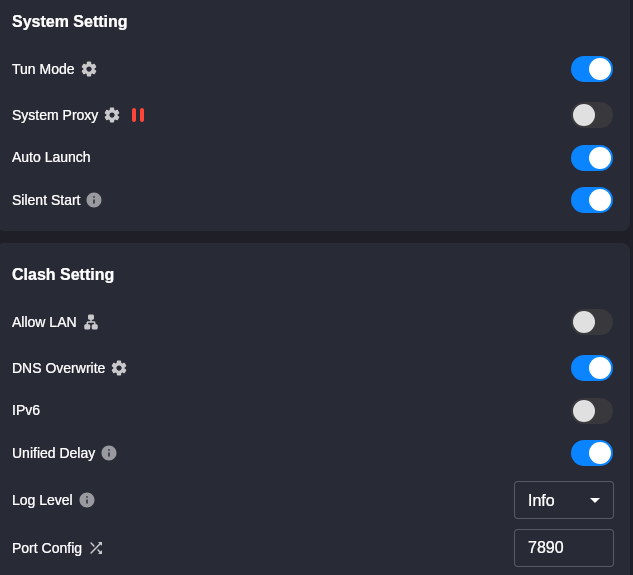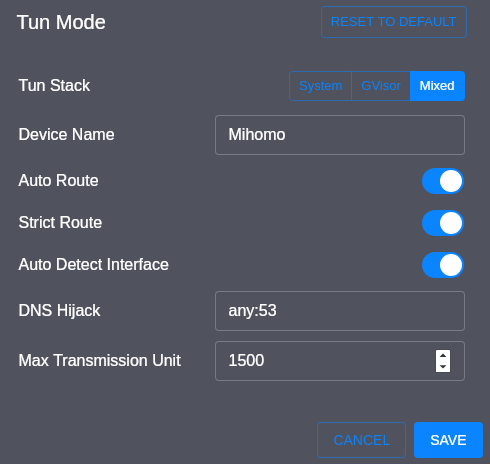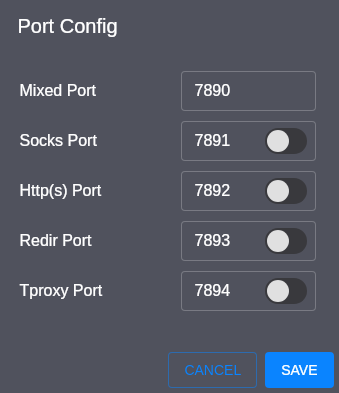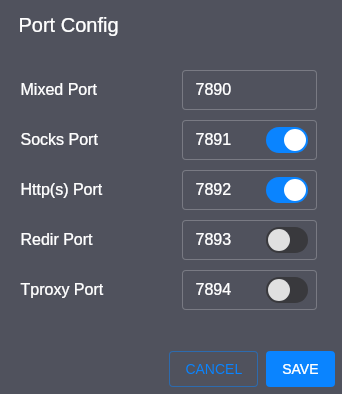Proxy or Die Trying: Troubleshooting of Ports, Git, and Clash on Linux
A hands-on walkthrough of debugging Clash's HTTP & SOCKS proxy ports on Linux, configuring git/pip access, and switching ports with custom shell aliases.
If you’re using a non-jailbroken iPhone, you may need to use
Shadowrocketmake this Pi + Clash setup work properly.
Make sure your phone or router allows IPv6 to be disabled before you commit to this setup.
So let’s say you’ve successfully set up Pi-hole for all your devices-your Phone, your PC, everything - maybe using this blog 👉🏻 Building a Pi-Hole DNS Firewall with Clash VPN Routing - Wireless, Leak-Free, No-Cable Setup.
But then… the network gets way more complex than I ever expected.
Back when things were simpler, I could handle everything just fine.
But BOOM, packets started getting messed up, ports got phucked.
I finally managed to troubleshoot everything after several hours (and yeah, I’m still kinda confused about what’s actually happening under the hood).
Hopefully, anyone reading this can solve similar issues too, and faster than I did!!
☠️ The Phreaking Trouble
- Clash Verge failed to update the subscription file when TUN was enabled - like it couldn’t reach the internet at all. All nodes showed timeout.
- Switched to system proxy - file update worked, but nodes still timed out. Or sometimes connected, but IP wasn’t the node’s.
- Either way, when I hit
Test Allin Clash Verge, it didn’t even show the loading circle - just failed. - After setting SOCKS5 Proxy in Firefox, all apps and non-proxy (DIRECT) sites became inaccessible, even router IPs like
192.168.1.1. - When I turned off Firefox SOCKS5 Proxy, Firefox worked normally (or couldn’t access foreign sites if you’re in a place with extremely phreaking insane internet restrictions).
🦊 Reconnect to Your VPN on PC (The Fast & Dirty Fix) - Set a SOCKS5 Proxy in Firefox
Let’s say Mihomo/Clash is working perfectly on your Pi, and every other device using the Pi as their gateway is enjoying that sweet, free internet like a bunch of jolly bunnies. 🐰
Well then - this is the fastest way to reconnect your PC browser to the VPN.
(It has its limits though - it’ll only work for your browser, not the whole system.)
🎯 What We Want to Achieve
Send all Firefox traffic (and DNS lookups) through:
- SOCKS5 Proxy
- At IP:
<Pi_IP> - Port:
7890(default Mihomo mixed port)
✅ EXACT Settings to Fill
| Field | Value |
|---|---|
| SOCKS Host | <Pi_IP> |
| Port | 7890 |
| SOCKS v5 | ✅ Check this |
| Proxy DNS when using SOCKS v5 | ✅ Check this (important!) |
| Leave HTTP/HTTPS Proxy fields blank | ❌ do not fill |
| No proxy for | localhost, 127.0.0.1 |
You DO NOT need to check “Use this proxy for HTTPS” or fill HTTP/HTTPS fields - you’re using SOCKS only.
🧪 To Confirm It Works
- Open Firefox
- Visit: https://api.myip.com → You should see Node IP 🌎
- Go to: https://browserleaks.com/dns → You should NOT see local ISP DNS - only foreign ones
If it doesn’t work:
- Make sure your Mihomo is actually running on the Pi
- Confirm
allow-lan: trueis in the config - Confirm
mixed-port: 7890is open on all interfaces (0.0.0.0) - From your PC, try:
1
curl --proxy socks5h://<Pi_IP>:7890 https://api.myip.com
🍓 Shut up - Pi!
We are gonna reset all network settings and turn off your Pi setup without breaking anything.
This would Temporarily cut all the complexity and get your PC back to a fresh, clean internet state (no proxy, no strange gateway routes, no DNS tweaks).
✅ 1. Turn Off Pi First
Just SSH in and:
1
sudo shutdown now
Or unplug it directly if you’re sure it’s safe.
✅ 2. Reset PC Network Config to Default
Make sure your router isn’t still using the Pi’s static IP as its DNS.
If it is, log into your router’s settings and change the DNS to something else.
Then you can delete all saved configs:
1
2
sudo rm /etc/NetworkManager/system-connections/*
sudo systemctl restart NetworkManager
✅ 3. Make Sure These Are Back to Defaults
- IPv4 Method:
Automatic (DHCP) - DNS: leave blank (or toggle “Automatic” on)
- Gateway: will auto-fill
- Proxy in Firefox: Set to
No ProxyorUse system settings
🔄 4. (Optional) Reboot
Just to be clean:
1
sudo reboot
🧼 What This Resets:
- IP config (static → auto)
- DNS (custom → default)
- Proxy (if using Firefox)
- No more routing through Pi
- Reverts to router → ISP
😿 Reinstall Clash Verge, Wipe That Pain Away
SOCKS5 Proxy in Firefox only helps Firefox itself - so yeah, it’s just an emergency band-aid.
Now, you’ve turned off that Firefox SOCKS5 setting. It’s time to reinstall Clash Verge.
Trust me - your pain’s about to drift far, far away. (At least you’ll be able to open GitHub again… right? 🤨)
As for Clash CLI?
Not today. (Truth: it fails way too easily in this condition.)
Even Grandma prefers a GUI - and honestly? So do I.
WARNING: Make sure you’ve backed up your config file or your subscription link before you wipe anything!
1. Uninstall the current one
1
2
sudo apt remove clash-verge
sudo apt purge clash-verge
“Purge” deletes config files stored in system paths (but not in ~/.config/)
2. Clean leftover user configs
1
2
rm -rf ~/.config/clash-verge*
rm -rf ~/.local/share/clash-verge*
Optional:
1
rm -rf ~/.config/clash/
3. Reinstall the latest .deb
1
2
wget https://github.com/clash-verge-rev/clash-verge-rev/releases/download/v2.2.3/Clash.Verge_2.2.3_amd64.deb
sudo apt install ./Clash.Verge_2.2.3_amd64.deb
Then launch it:
1
clash-verge
✅ After Reinstalling - Setting Example
- Reimport your config or subscribe again
- Toggle something on like this setting example
⛓️ TUN
Enable TUN, check if there’s any tips showed up to install TUN service. Make sure it is properly downloaded.
After enabling TUN:
1
2
sudo ip route flush table main
sudo systemctl restart NetworkManager
Optional debug:
1
ip route show table main
💻 DNS Overwrite
Try this, harmless, fr 🌻
1
2
3
4
5
6
7
8
9
10
11
12
13
14
15
16
17
18
19
20
enable: true
enhanced-mode: fake-ip
fake-ip-filter:
- '*.lan'
- '*.local'
- '*.arpa'
- localhost.ptlogin2.qq.com
- msftncsi.com
- www.msftconnecttest.com
fake-ip-range: 198.18.0.1/16
fallback:
- https://1.1.1.1/dns-query
- https://dns.google/dns-query
listen: :53
nameserver:
- 8.8.8.8
- 1.1.1.1
- https://dns.google/dns-query
- https://cloudflare-dns.com/dns-query
DO NOT use any Pi IP for DNS inside Clash, or it will break when Pi is off.
🪦 Disable IPv6 (important)
Do this part both on your PC and Pi!
IPv6 can potentially leak your DNS.
Disable IPv6 globally - make your OS and router forget it ever existed:
1
2
3
4
5
6
7
8
# For Linux (temporary)
sudo sysctl -w net.ipv6.conf.all.disable_ipv6=1
# To make it permanent:
echo "net.ipv6.conf.all.disable_ipv6 = 1" | sudo tee -a /etc/sysctl.conf
echo "net.ipv6.conf.eth0.disable_ipv6 = 1" | sudo tee -a /etc/sysctl.conf
echo "net.ipv6.conf.wlan0.disable_ipv6 = 1" | sudo tee -a /etc/sysctl.conf
sudo sysctl -p
Use
ip ato check if it’seth0andwlan0.Make sure to check under
Settings➡️Networkand see ifIPv6is deactivated.Don’t forget to disable IPv6 and remove IPv6 DNS on your phone as well - and make sure you’re only using your safe DNS servers.
- When combining Pi with Clash, I haven’t found a way to disable IPv6 on a non-jailbroken iPhone.
Shadowrocketcan effectively block IPv6 traffic on iPhone.- IPv6 can leak even without a DNS leak - every device gets a unique, traceable IPv6 address.
If you’re using a non-jailbroken iPhone, enable
shadowrocketinDIRECTwith a proper config file, or this Pi + Clash setup could still result in an IPv6 leak.
🔍 How to Check If IPv6 Is Fully Disabled
1
ip a | grep inet6
You should see:
- No global
inet6lines for your interfaces (nothing) - At most, maybe 1 loopback like
::1(that’s fine)
Or this:
1
cat /proc/sys/net/ipv6/conf/all/disable_ipv6
- If it returns
1→ IPv6 is disabled - If it returns
0→ still active
Also check with ip.sb.
🚪 Port Config:
- Go to
Port Configsection. - Click the blue “Random Port” icon once - that will unlock it temporarily.
They are editable now, type in the following (a classic combo):
1 2 3 4 5
Mixed: 7890 HTTP: 7891 Socks: 7892 Redir: 7893 TProxy: 7894
- Click SAVE.
- Restart the core (or restart Clash Verge if needed).
TL;DR Cheat Sheet
| Feature | Should Be… | Why |
|---|---|---|
| TUN Mode | ON | Reroutes all traffic |
| System Proxy | OFF | No conflict with TUN |
| DNS Overwrite | ON | Prevents leak + DNS injection |
| Port Config | Static 789x | Let you use curl/scripts reliably |
| Firefox | No Proxy | TUN mode handles everything |
🧠 Final Troubleshoot!
Make sure you can successfully select a node, no more “all timeout”!
You’re doing so good right now! 😼 Try:
1
2
curl --proxy http://127.0.0.1:7890 https://api.myip.com
curl https://api.myip.com # Without proxy, test real route
If they show different IPs, proxy working.
But if only shows node IP, you may already have phree Internet now.
😾 Clash is not Listening the Right Port 7890
If you met condition like this:
curl --proxy http://127.0.0.1:7890→ connection refused
1
2
3
4
5
> curl --proxy http://127.0.0.1:7890 https://api.myip.com
{"ip":"<Node_IP>","country":"<Node_Country>","cc":"<Node_Country>"}%
curl https://api.myip.com
curl: (7) Failed to connect to 127.0.0.1 port 7890 after 0 ms: Connection refused
This happens probably cause Clash is not listening the right port 7890, but on other port.
Let’s try:
1
lsof -i -P -n | grep LISTEN | grep clash
If it shows something like this:
1
clash-ver 10693 $USERNAME 21u IPv4 82026 0t0 TCP 127.0.0.1:33331 (LISTEN)
then we know:
| Field | Meaning |
|---|---|
clash-ver | The binary running - your Clash Verge core ✅ |
10693 | The PID of your Clash core process |
127.0.0.1:33331 | The port it’s currently listening on for controller/web API stuff |
(LISTEN) | It’s active and receiving connections 🧩 |
🤔 Possible Solution
This may affect tools like git, curl stuff, and others. Normally, we’d set:
1
2
http.proxy=http://127.0.0.1:7890
https.proxy=http://127.0.0.1:7890
in Git config.
But in this case, the proxy isn’t running on 127.0.0.1:7890.
(Yeah, even if you explicitly set the Mixed Port to 7890, it might not apply immediately.)
Instead, it could be using a different port - like that 33331 I showed you earlier using lsof.
If you try to install a library with pip, you might get something like:
Failed to establish a new connection: [Errno 111] Connection refused
But you might think:
“Why not just update Git to use the correct (but kinda weird) port?”
Okay, let’s do that:
1
2
git config --global http.proxy http://127.0.0.1:33331
git config --global https.proxy http://127.0.0.1:33331
Double check it worked:
1
2
git config --global --get http.proxy
git config --global --get https.proxy
You should see:
1
2
http://127.0.0.1:33331
http://127.0.0.1:33331
Sure, that works for Git mostly.
But pip still probably won’t work.
And just in case the weird port changes again for some unknown reason…
💡 Solve Port Issues
So now, try to toggle both the HTTP(S) and SOCKS proxy ports to “on”:
Then open your shell config:
1
nano ~/zshrc
or, if you’re using Bash:
1
nano ~/bashrc
Add the following lines at the end of the file:
1
2
3
4
5
6
7
8
9
10
11
12
13
14
15
16
17
18
19
20
21
22
23
# 🚫 Always skip proxy for local/private addresses
export NO_PROXY="localhost,127.0.0.1,::1,192.168.0.0/16,10.0.0.0/8,172.16.0.0/12"
# 🌩️ Clash Proxy for tools like curl/pip
export http_proxy="http://127.0.0.1:7892"
export https_proxy="http://127.0.0.1:7892"
export all_proxy="socks5://127.0.0.1:7891"
# 🧙 Git Proxy Toggles
# Add more if you use other proxy clients
alias git-proxy-clash='git config --global http.proxy http://127.0.0.1:7892 && git config --global https.proxy http://127.0.0.1:7892'
alias git-proxy-off='git config --global --unset http.proxy && git config --global --unset https.proxy'
# 🔁 Shell-wide Proxy Aliases
# Add more if you use other proxy clients
alias proxy-on-clash='export http_proxy="http://127.0.0.1:7892"; export https_proxy=$http_proxy; export all_proxy="socks5://127.0.0.1:7892"'
alias proxy-off='unset http_proxy https_proxy all_proxy'
# 💡 Check current status
alias proxy-status='echo "🌐 http_proxy: $http_proxy"; \
echo "🧊 https_proxy: $https_proxy"; \
echo "🕳️ all_proxy: $all_proxy"; \
echo "🚫 no_proxy: $NO_PROXY"'
Now try pip again, and HELL YEA! That’s what we are talking about! 😾
🧠 Understand git config & export http_proxy & export all_proxy
1️⃣ The git config ones (e.g. git-proxy-clash)
They only affect Git, and they persist globally (across reboots/shells) because they directly modify your Git config:
1
git config --global http.proxy ...
They are stored in ~/.gitconfig, so even if you reboot or close your terminal, Git will still use the proxy until you unset.
Use this when:
- You’re having trouble pushing/pulling from GitHub or GitLab behind internet restrictions
- You want Git to always use a specific proxy no matter the shell or script
2️⃣ The export http_proxy ones (e.g. proxy-on)
These affect the whole shell environment, and work with any CLI tool that respects http_proxy, https_proxy, and all_proxy, like:
pipwget,curlnpmapt, etc. But they only last for the current terminal session, unless added to~/.zshrc.
Use this when:
- You want tools like
pip,curl,npmto go through your proxy - You’re temporarily testing something in a shell session
3️⃣ The export all_proxy ones (e.g. proxy-on)
1
export all_proxy="socks5://127.0.0.1:7892"
This means:
“Any program that understands all_proxy (like curl, apt, or some Python scripts) should send all network traffic through a SOCKS5 proxy at 127.0.0.1:7892.”
🔧 Tools That Expect SOCKS?
These are apps or environments that read all_proxy and route all protocols (TCP/UDP) via SOCKS-some don’t care if it’s HTTP or SOCKS, they just want to tunnel. Typical examples include:
curl(if you specify--socks5)apt(if explicitly configured to use SOCKS)python requestsif you setall_proxyconda,npm, and even some Electron-based apps- Git (in some cases) - mostly prefers
http_proxy, but fallback is possible
- ✅
Mixed Port(7890): for GUI, internal core, or apps like Clash Dashboard - ✅
HTTP(S) Port(7892): for pip, curl, git - ✅
SOCKS Port(7891): for tools supporting SOCKS5 or when usingall_proxy
Once you found:
1
verge-mih 17100 root ... TCP localhost:7890 (LISTEN)
That means Clash Verge’s core is alive and well. Your whole kingdom is back online.
This is golden if:
- You wanna install packages (
pip,npm,curl, etc.) over internet restrictions - You have
SOCKStoggle on - You’re switching tools and protocols without confusion
Extra note: if the SOCKS toggle is off, the all_proxy=socks5://127.0.0.1:7891 would silently fail for tools that try SOCKS only (like some weird apt or IRC clients). So keep both 7891 + 7892 toggled on if you’re setting all three proxy envs.
🐈 Final Thoughts for Pi + Clash
Pi does work great with Clash CLI - no doubt. But if you:
- don’t want your Pi messing with your PC’s DNS
- like to frequently tinker with proxy clients on your PC
- prefer more control and flexibility in your network setup
Then maybe just leave your Pi’s phree internet for your other devices like your phone, iPad, etc.
And seriously, don’t use the Pi’s DNS on your PC.
Just activate your proxy directly on the PC, and go wild with your own rules and configs.

